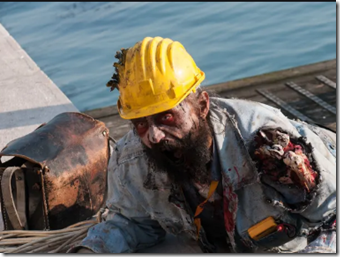Originally posted on October 31, 2019 @ 6:30 PM
 Halloween is not an Australian thing indeed, as a child in the 1960s and 1970s there was simply no interest in Halloween in Australia. However, with growing syncretism between US and Australian cultures since the Vietnam War the festival and commercialism of Halloween has been growing Down Under. A good read about this is here (https://www.timeanddate.com/holidays/australia/halloween ).
Halloween is not an Australian thing indeed, as a child in the 1960s and 1970s there was simply no interest in Halloween in Australia. However, with growing syncretism between US and Australian cultures since the Vietnam War the festival and commercialism of Halloween has been growing Down Under. A good read about this is here (https://www.timeanddate.com/holidays/australia/halloween ).
What is most fascinating about the emergence of Halloween in Australia is not just the way the media have manufactured it commercially but also the way Australians have welcomed its superstitions, rituals and semiotics. We can learn much about culture from the rituals, semiotics and rites of Halloween. (Further read Douglas, M., ‘Purity and Danger’; ‘Risk and Blame’ )
There are of course those in Christian sects and traditions that completely reject Halloween as Satanist but the festival actually began as a Christian festival to remember the dead. Remembering the death of others is a healthy reminder of human fallibility (https://www.humandymensions.com/product/fallibility-risk-living-uncertainty/) and teleios. One of the crazy things about the zero discourse in Safety is the by-product of the denial of death (Becker, E., The Denial of Death). I wrote about this 5 years ago on this blog (https://safetyrisk.net/my-target-goal-is-zero-death/).
One of my lasting memories of working in the clergy is conducting funerals and memorial services. There is nothing more overwhelming than rolling the mechanism of tapes supporting a coffin as it submerges into the ground. It is in that moment that we hold a mirror to ourselves, when there are no words, no heroes, no infallibility to ‘save lives’ or ‘controls’, just the reality of mortality and heaps of unanswered questions provoking the futility of prayer.
Becker’s book should be compulsory reading for safety people. It documents how our society ‘hides’ what he calls ‘the terror of death’ and discusses ways in which we insulate ourselves in our culture from facing fallibility. His attack on heroics is extensive and helpful as is his connections to mental illness. Becker’s book is informed by his connections to Kierkegaard and Jung which is why I appreciate his work so much. The trouble is the moment we engage in discussions of death and suffering we surface metaphysical questions and mysteries that the STEM (positivist) worldview avoids. So, our society keeps the tough questions as arms length by keeping such questions to childish festivals and religious rites.
The recent closure of the Uluru climb is also relevant as the STEM worldview of conquering nature that came into conflict with the First Nations worldview of sacred place and space (https://www.abc.net.au/news/2019-10-27/traditional-owners-sammy-wilson-uluru-climb-closure/11643180 ). It seems Australians are happy as a society to confine First Nations rites and rituals to smoking ceremonies and dreamtime poetics but see no connection between Indigenous theology and connection to the land. Here, a reading of Dark Emu (https://www.booktopia.com.au/dark-emu-bruce-pascoe/book/9781921248016.html) is essential. It is a kind of cultural schizophrenia that sacralises ANZAC day yet makes no connection between Indigenous Dreamtime and climbing Uluru. I wrote about this disconnect in my experience of Canadian First People’s at a Safety Conference I attended (p77).
So Halloween and the festival of remembering the dead clearly helps us tap into the collective psyche that is intrigued about evil, death and the unanswered questions and uncertainties of dying. Perhaps it gives us a reality check about fallibility and the delusions of zero. Perhaps it might create greater appreciation of the vulnerabilities of mortality and less attraction to the denial of fallibility in zero. Perhaps we might appreciate that all of us are injured but we just can’t see it, much of it masked by medications, traditions and positivist notions of certainty. Perhaps Halloween helps us step away from STEM for just a moment to contemplate the metaphysical questions that STEM rejects.



bernardcorden says
Witchcraft or sanguma has far more credibility and integrity than the relentless anodyne sludge masquerading as evidence based material, which is churned out at most safety conferences by its thought leaders or evangelists. Indeed several quotes from the late Harold Laski resonate:
“A second class mind dealing with third rate material is hardly a necessity of life”
“A healthy loyalty is not passive and complacent but active and critical”
Richard says
Hi Rob; just gave out handfuls of sweets to the 30 odd kids who came our door- all dressed up having a wonderful time together (they’re only 10yo, lovely age). The connectedness of the group was effervescent.
Interesting I heard about an APP called ‘kick the bucket’ the other day that sends thoughtful messages each day about the need to live life to the fullest as you never know when it’s your turn; it’s not morbid just a quick reminder.
bernardcorden says
Witchcraft or sanguma has far more credibility and integrity than the relentless anodyne sludge masquerading as evidence based material, which is churned out at most safety conferences by its thought leaders or evangelists. Indeed several quotes from the late Harold Laski resonate:
“A second class mind dealing with third rate material is hardly a necessity of life”
“A healthy loyalty is not passive and complacent but active and critical”
Richard says
Hi Rob; just gave out handfuls of sweets to the 30 odd kids who came our door- all dressed up having a wonderful time together (they’re only 10yo, lovely age). The connectedness of the group was effervescent.
Interesting I heard about an APP called ‘kick the bucket’ the other day that sends thoughtful messages each day about the need to live life to the fullest as you never know when it’s your turn; it’s not morbid just a quick reminder.